Comprehensive Analysis of Patient Care Process in Merck & Co.
VerifiedAdded on 2019/10/18
|12
|2849
|499
Report
AI Summary
This report provides a comprehensive analysis of the patient care process implemented by Merck & Co., a major pharmaceutical organization. The report details the company's patient-centered approach, emphasizing team-based care to deliver high-quality and cost-effective healthcare services. It outlines the key steps in their patient care process, including forming patient-pharmacist relationships, collecting patient data, assessing patient needs, developing individualized care plans, implementing these plans, and continuous monitoring and evaluation. The report also applies the Donabedian model to evaluate the structure, process, and outcomes of Merck & Co.'s patient care, identifying potential areas for improvement and addressing issues like tampering and accidental processes. Furthermore, it highlights opportunities for enhancing patient care, such as improving accessibility and reducing waiting times, and discusses reasons for defects and deviation. The analysis covers various aspects, from medication management to emergency response functions, providing a holistic view of Merck & Co.'s commitment to patient well-being.
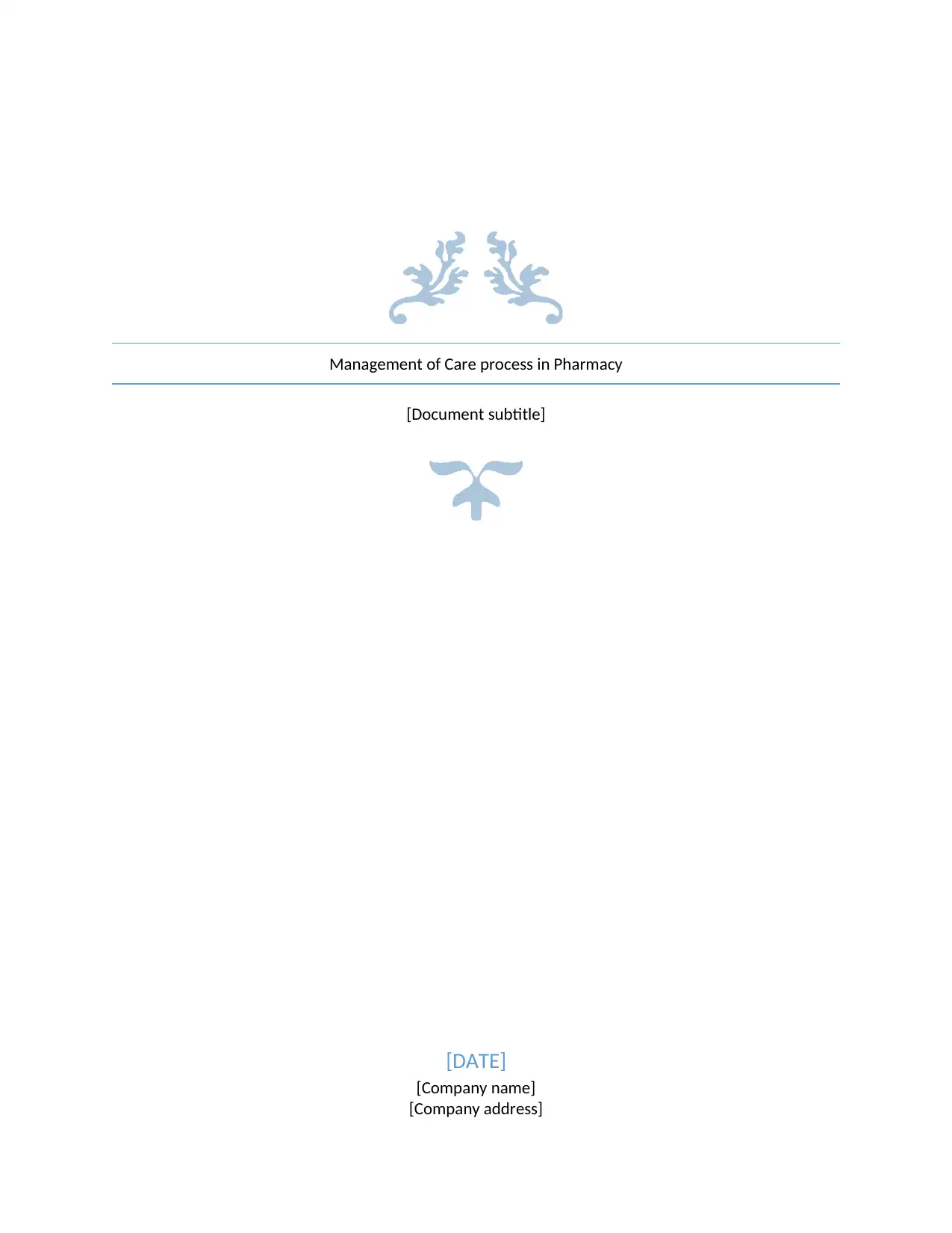
Management of Care process in Pharmacy
[Document subtitle]
[DATE]
[Company name]
[Company address]
[Document subtitle]
[DATE]
[Company name]
[Company address]
Paraphrase This Document
Need a fresh take? Get an instant paraphrase of this document with our AI Paraphraser
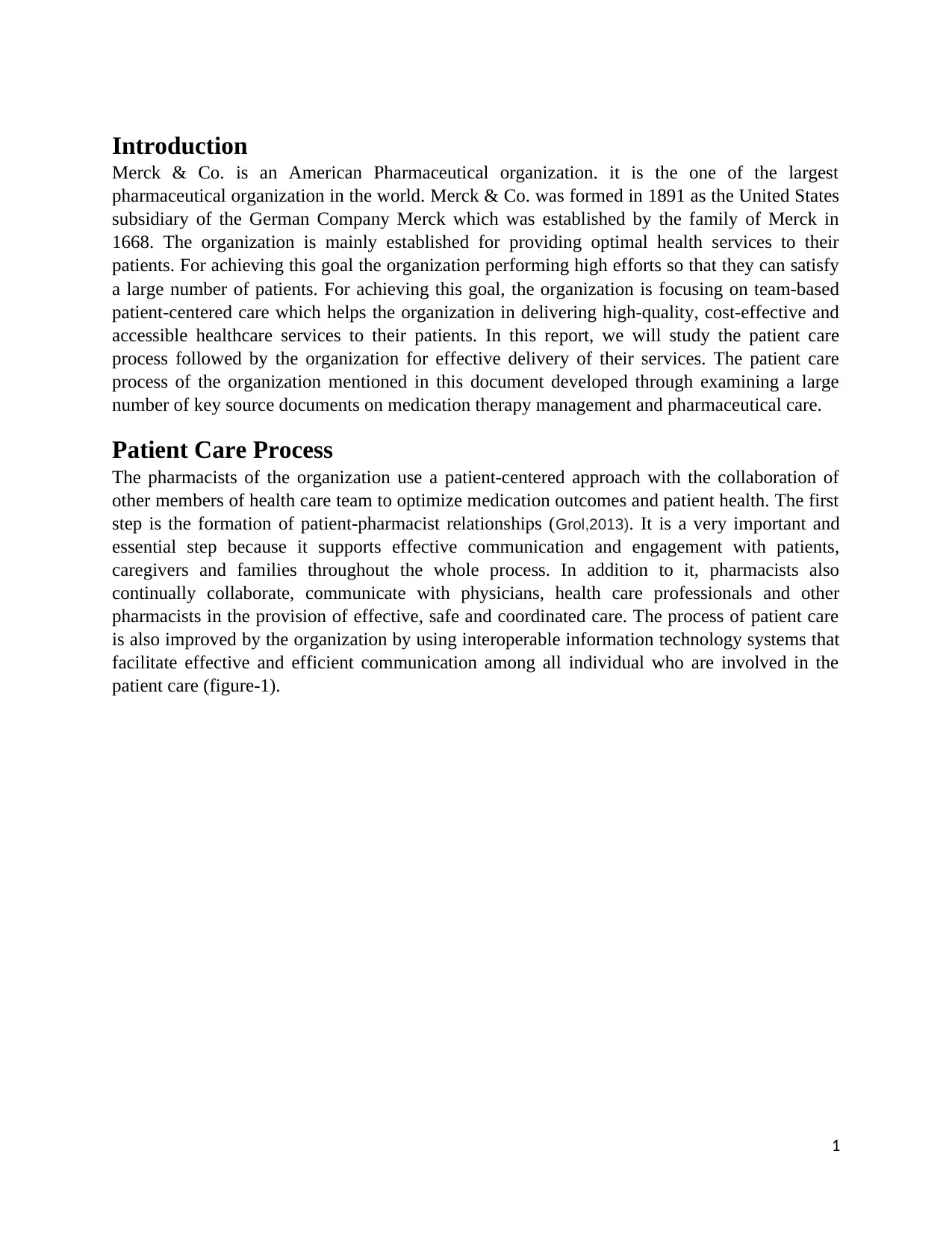
Introduction
Merck & Co. is an American Pharmaceutical organization. it is the one of the largest
pharmaceutical organization in the world. Merck & Co. was formed in 1891 as the United States
subsidiary of the German Company Merck which was established by the family of Merck in
1668. The organization is mainly established for providing optimal health services to their
patients. For achieving this goal the organization performing high efforts so that they can satisfy
a large number of patients. For achieving this goal, the organization is focusing on team-based
patient-centered care which helps the organization in delivering high-quality, cost-effective and
accessible healthcare services to their patients. In this report, we will study the patient care
process followed by the organization for effective delivery of their services. The patient care
process of the organization mentioned in this document developed through examining a large
number of key source documents on medication therapy management and pharmaceutical care.
Patient Care Process
The pharmacists of the organization use a patient-centered approach with the collaboration of
other members of health care team to optimize medication outcomes and patient health. The first
step is the formation of patient-pharmacist relationships (Grol,2013). It is a very important and
essential step because it supports effective communication and engagement with patients,
caregivers and families throughout the whole process. In addition to it, pharmacists also
continually collaborate, communicate with physicians, health care professionals and other
pharmacists in the provision of effective, safe and coordinated care. The process of patient care
is also improved by the organization by using interoperable information technology systems that
facilitate effective and efficient communication among all individual who are involved in the
patient care (figure-1).
1
Merck & Co. is an American Pharmaceutical organization. it is the one of the largest
pharmaceutical organization in the world. Merck & Co. was formed in 1891 as the United States
subsidiary of the German Company Merck which was established by the family of Merck in
1668. The organization is mainly established for providing optimal health services to their
patients. For achieving this goal the organization performing high efforts so that they can satisfy
a large number of patients. For achieving this goal, the organization is focusing on team-based
patient-centered care which helps the organization in delivering high-quality, cost-effective and
accessible healthcare services to their patients. In this report, we will study the patient care
process followed by the organization for effective delivery of their services. The patient care
process of the organization mentioned in this document developed through examining a large
number of key source documents on medication therapy management and pharmaceutical care.
Patient Care Process
The pharmacists of the organization use a patient-centered approach with the collaboration of
other members of health care team to optimize medication outcomes and patient health. The first
step is the formation of patient-pharmacist relationships (Grol,2013). It is a very important and
essential step because it supports effective communication and engagement with patients,
caregivers and families throughout the whole process. In addition to it, pharmacists also
continually collaborate, communicate with physicians, health care professionals and other
pharmacists in the provision of effective, safe and coordinated care. The process of patient care
is also improved by the organization by using interoperable information technology systems that
facilitate effective and efficient communication among all individual who are involved in the
patient care (figure-1).
1
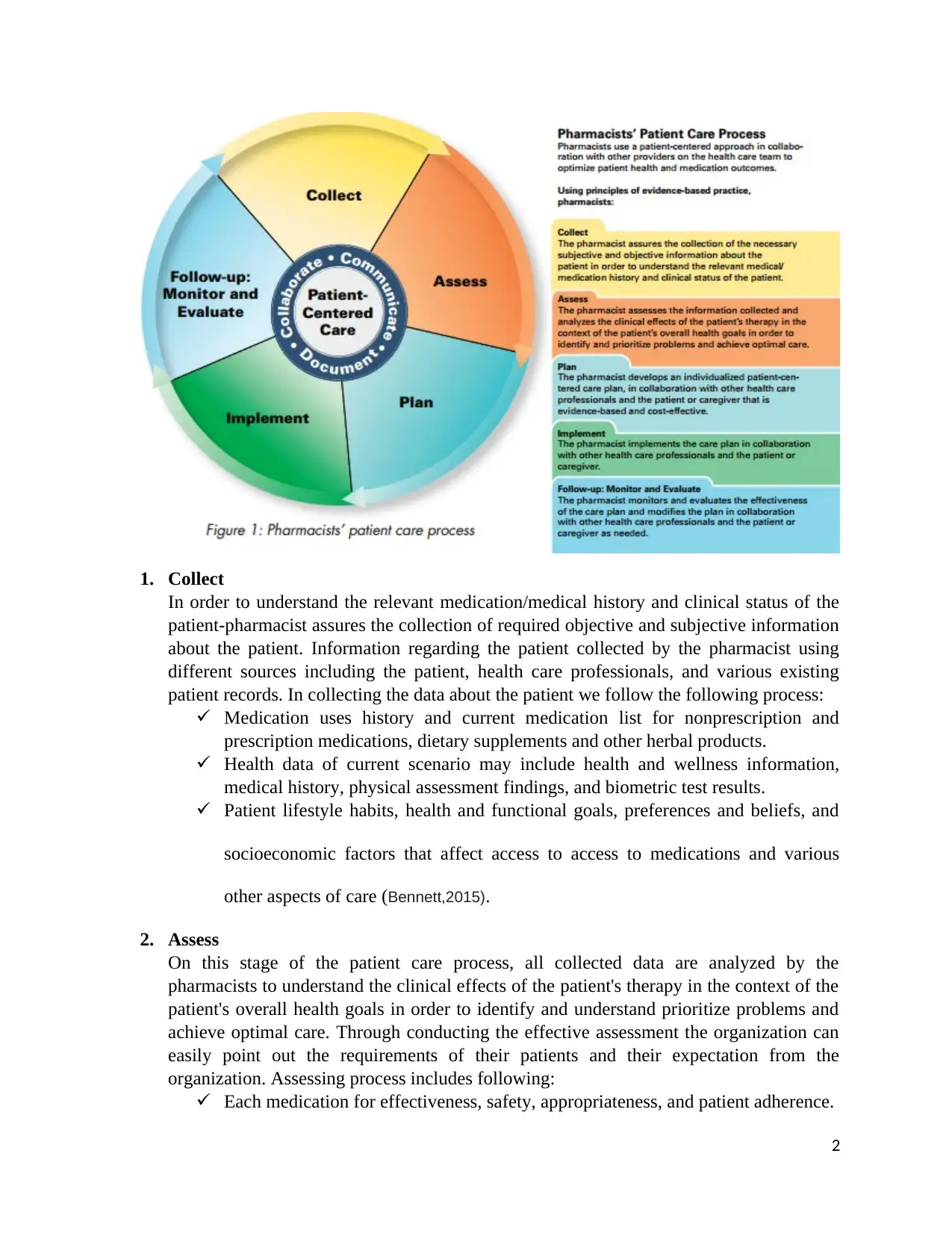
1. Collect
In order to understand the relevant medication/medical history and clinical status of the
patient-pharmacist assures the collection of required objective and subjective information
about the patient. Information regarding the patient collected by the pharmacist using
different sources including the patient, health care professionals, and various existing
patient records. In collecting the data about the patient we follow the following process:
Medication uses history and current medication list for nonprescription and
prescription medications, dietary supplements and other herbal products.
Health data of current scenario may include health and wellness information,
medical history, physical assessment findings, and biometric test results.
Patient lifestyle habits, health and functional goals, preferences and beliefs, and
socioeconomic factors that affect access to access to medications and various
other aspects of care (Bennett,2015).
2. Assess
On this stage of the patient care process, all collected data are analyzed by the
pharmacists to understand the clinical effects of the patient's therapy in the context of the
patient's overall health goals in order to identify and understand prioritize problems and
achieve optimal care. Through conducting the effective assessment the organization can
easily point out the requirements of their patients and their expectation from the
organization. Assessing process includes following:
Each medication for effectiveness, safety, appropriateness, and patient adherence.
2
In order to understand the relevant medication/medical history and clinical status of the
patient-pharmacist assures the collection of required objective and subjective information
about the patient. Information regarding the patient collected by the pharmacist using
different sources including the patient, health care professionals, and various existing
patient records. In collecting the data about the patient we follow the following process:
Medication uses history and current medication list for nonprescription and
prescription medications, dietary supplements and other herbal products.
Health data of current scenario may include health and wellness information,
medical history, physical assessment findings, and biometric test results.
Patient lifestyle habits, health and functional goals, preferences and beliefs, and
socioeconomic factors that affect access to access to medications and various
other aspects of care (Bennett,2015).
2. Assess
On this stage of the patient care process, all collected data are analyzed by the
pharmacists to understand the clinical effects of the patient's therapy in the context of the
patient's overall health goals in order to identify and understand prioritize problems and
achieve optimal care. Through conducting the effective assessment the organization can
easily point out the requirements of their patients and their expectation from the
organization. Assessing process includes following:
Each medication for effectiveness, safety, appropriateness, and patient adherence.
2
⊘ This is a preview!⊘
Do you want full access?
Subscribe today to unlock all pages.

Trusted by 1+ million students worldwide
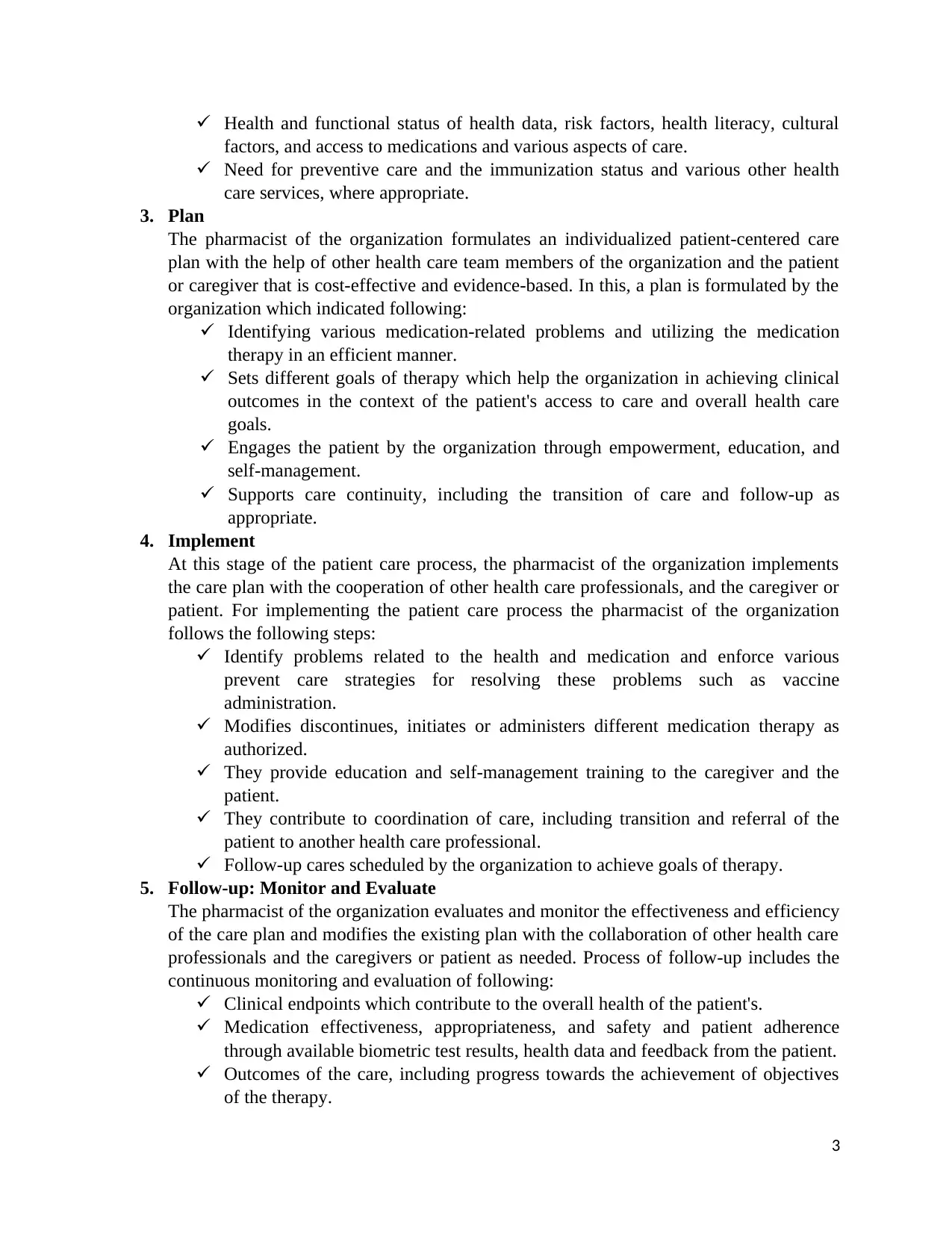
Health and functional status of health data, risk factors, health literacy, cultural
factors, and access to medications and various aspects of care.
Need for preventive care and the immunization status and various other health
care services, where appropriate.
3. Plan
The pharmacist of the organization formulates an individualized patient-centered care
plan with the help of other health care team members of the organization and the patient
or caregiver that is cost-effective and evidence-based. In this, a plan is formulated by the
organization which indicated following:
Identifying various medication-related problems and utilizing the medication
therapy in an efficient manner.
Sets different goals of therapy which help the organization in achieving clinical
outcomes in the context of the patient's access to care and overall health care
goals.
Engages the patient by the organization through empowerment, education, and
self-management.
Supports care continuity, including the transition of care and follow-up as
appropriate.
4. Implement
At this stage of the patient care process, the pharmacist of the organization implements
the care plan with the cooperation of other health care professionals, and the caregiver or
patient. For implementing the patient care process the pharmacist of the organization
follows the following steps:
Identify problems related to the health and medication and enforce various
prevent care strategies for resolving these problems such as vaccine
administration.
Modifies discontinues, initiates or administers different medication therapy as
authorized.
They provide education and self-management training to the caregiver and the
patient.
They contribute to coordination of care, including transition and referral of the
patient to another health care professional.
Follow-up cares scheduled by the organization to achieve goals of therapy.
5. Follow-up: Monitor and Evaluate
The pharmacist of the organization evaluates and monitor the effectiveness and efficiency
of the care plan and modifies the existing plan with the collaboration of other health care
professionals and the caregivers or patient as needed. Process of follow-up includes the
continuous monitoring and evaluation of following:
Clinical endpoints which contribute to the overall health of the patient's.
Medication effectiveness, appropriateness, and safety and patient adherence
through available biometric test results, health data and feedback from the patient.
Outcomes of the care, including progress towards the achievement of objectives
of the therapy.
3
factors, and access to medications and various aspects of care.
Need for preventive care and the immunization status and various other health
care services, where appropriate.
3. Plan
The pharmacist of the organization formulates an individualized patient-centered care
plan with the help of other health care team members of the organization and the patient
or caregiver that is cost-effective and evidence-based. In this, a plan is formulated by the
organization which indicated following:
Identifying various medication-related problems and utilizing the medication
therapy in an efficient manner.
Sets different goals of therapy which help the organization in achieving clinical
outcomes in the context of the patient's access to care and overall health care
goals.
Engages the patient by the organization through empowerment, education, and
self-management.
Supports care continuity, including the transition of care and follow-up as
appropriate.
4. Implement
At this stage of the patient care process, the pharmacist of the organization implements
the care plan with the cooperation of other health care professionals, and the caregiver or
patient. For implementing the patient care process the pharmacist of the organization
follows the following steps:
Identify problems related to the health and medication and enforce various
prevent care strategies for resolving these problems such as vaccine
administration.
Modifies discontinues, initiates or administers different medication therapy as
authorized.
They provide education and self-management training to the caregiver and the
patient.
They contribute to coordination of care, including transition and referral of the
patient to another health care professional.
Follow-up cares scheduled by the organization to achieve goals of therapy.
5. Follow-up: Monitor and Evaluate
The pharmacist of the organization evaluates and monitor the effectiveness and efficiency
of the care plan and modifies the existing plan with the collaboration of other health care
professionals and the caregivers or patient as needed. Process of follow-up includes the
continuous monitoring and evaluation of following:
Clinical endpoints which contribute to the overall health of the patient's.
Medication effectiveness, appropriateness, and safety and patient adherence
through available biometric test results, health data and feedback from the patient.
Outcomes of the care, including progress towards the achievement of objectives
of the therapy.
3
Paraphrase This Document
Need a fresh take? Get an instant paraphrase of this document with our AI Paraphraser
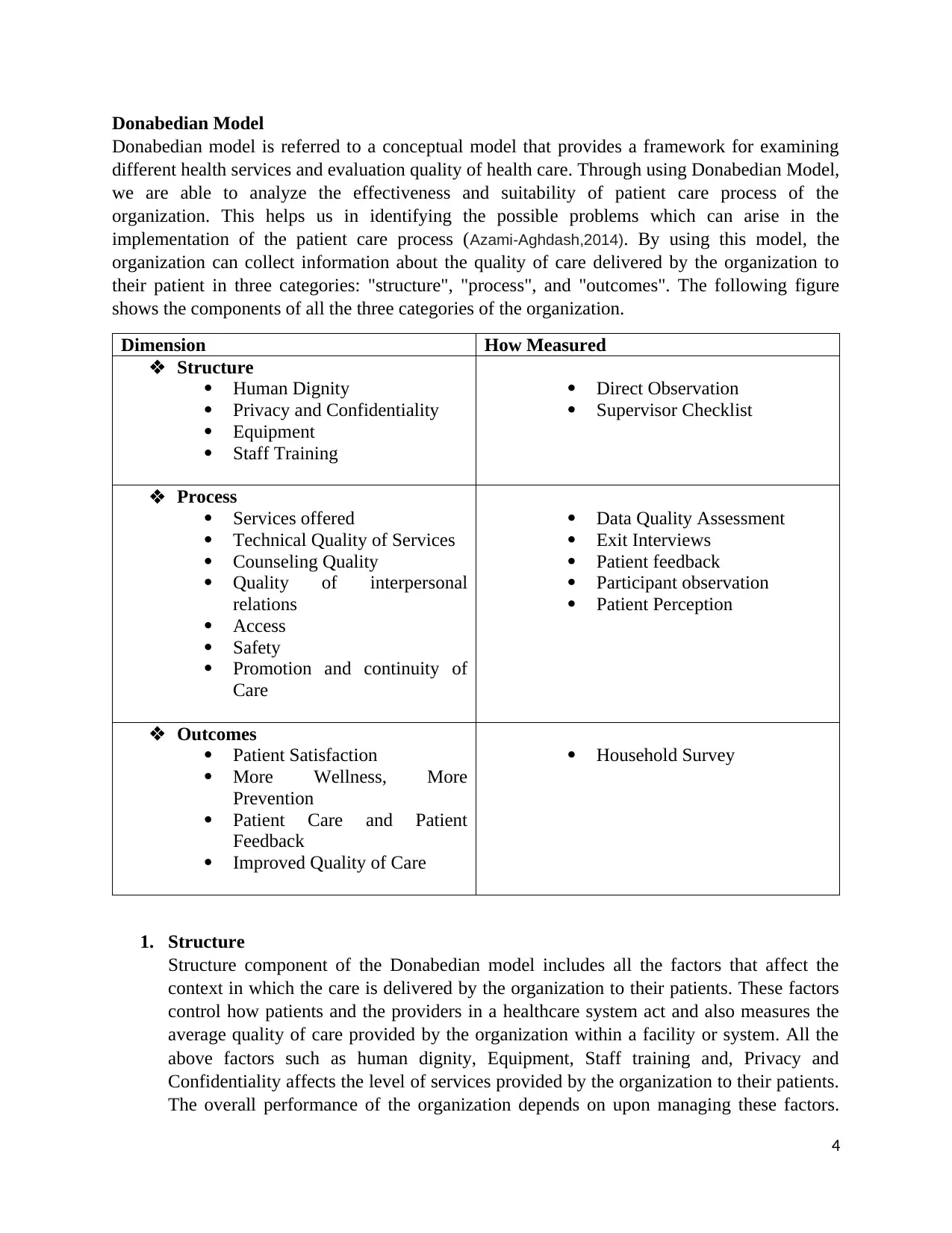
Donabedian Model
Donabedian model is referred to a conceptual model that provides a framework for examining
different health services and evaluation quality of health care. Through using Donabedian Model,
we are able to analyze the effectiveness and suitability of patient care process of the
organization. This helps us in identifying the possible problems which can arise in the
implementation of the patient care process (Azami-Aghdash,2014). By using this model, the
organization can collect information about the quality of care delivered by the organization to
their patient in three categories: "structure", "process", and "outcomes". The following figure
shows the components of all the three categories of the organization.
Dimension How Measured
Structure
Human Dignity
Privacy and Confidentiality
Equipment
Staff Training
Direct Observation
Supervisor Checklist
Process
Services offered
Technical Quality of Services
Counseling Quality
Quality of interpersonal
relations
Access
Safety
Promotion and continuity of
Care
Data Quality Assessment
Exit Interviews
Patient feedback
Participant observation
Patient Perception
Outcomes
Patient Satisfaction
More Wellness, More
Prevention
Patient Care and Patient
Feedback
Improved Quality of Care
Household Survey
1. Structure
Structure component of the Donabedian model includes all the factors that affect the
context in which the care is delivered by the organization to their patients. These factors
control how patients and the providers in a healthcare system act and also measures the
average quality of care provided by the organization within a facility or system. All the
above factors such as human dignity, Equipment, Staff training and, Privacy and
Confidentiality affects the level of services provided by the organization to their patients.
The overall performance of the organization depends on upon managing these factors.
4
Donabedian model is referred to a conceptual model that provides a framework for examining
different health services and evaluation quality of health care. Through using Donabedian Model,
we are able to analyze the effectiveness and suitability of patient care process of the
organization. This helps us in identifying the possible problems which can arise in the
implementation of the patient care process (Azami-Aghdash,2014). By using this model, the
organization can collect information about the quality of care delivered by the organization to
their patient in three categories: "structure", "process", and "outcomes". The following figure
shows the components of all the three categories of the organization.
Dimension How Measured
Structure
Human Dignity
Privacy and Confidentiality
Equipment
Staff Training
Direct Observation
Supervisor Checklist
Process
Services offered
Technical Quality of Services
Counseling Quality
Quality of interpersonal
relations
Access
Safety
Promotion and continuity of
Care
Data Quality Assessment
Exit Interviews
Patient feedback
Participant observation
Patient Perception
Outcomes
Patient Satisfaction
More Wellness, More
Prevention
Patient Care and Patient
Feedback
Improved Quality of Care
Household Survey
1. Structure
Structure component of the Donabedian model includes all the factors that affect the
context in which the care is delivered by the organization to their patients. These factors
control how patients and the providers in a healthcare system act and also measures the
average quality of care provided by the organization within a facility or system. All the
above factors such as human dignity, Equipment, Staff training and, Privacy and
Confidentiality affects the level of services provided by the organization to their patients.
The overall performance of the organization depends on upon managing these factors.
4
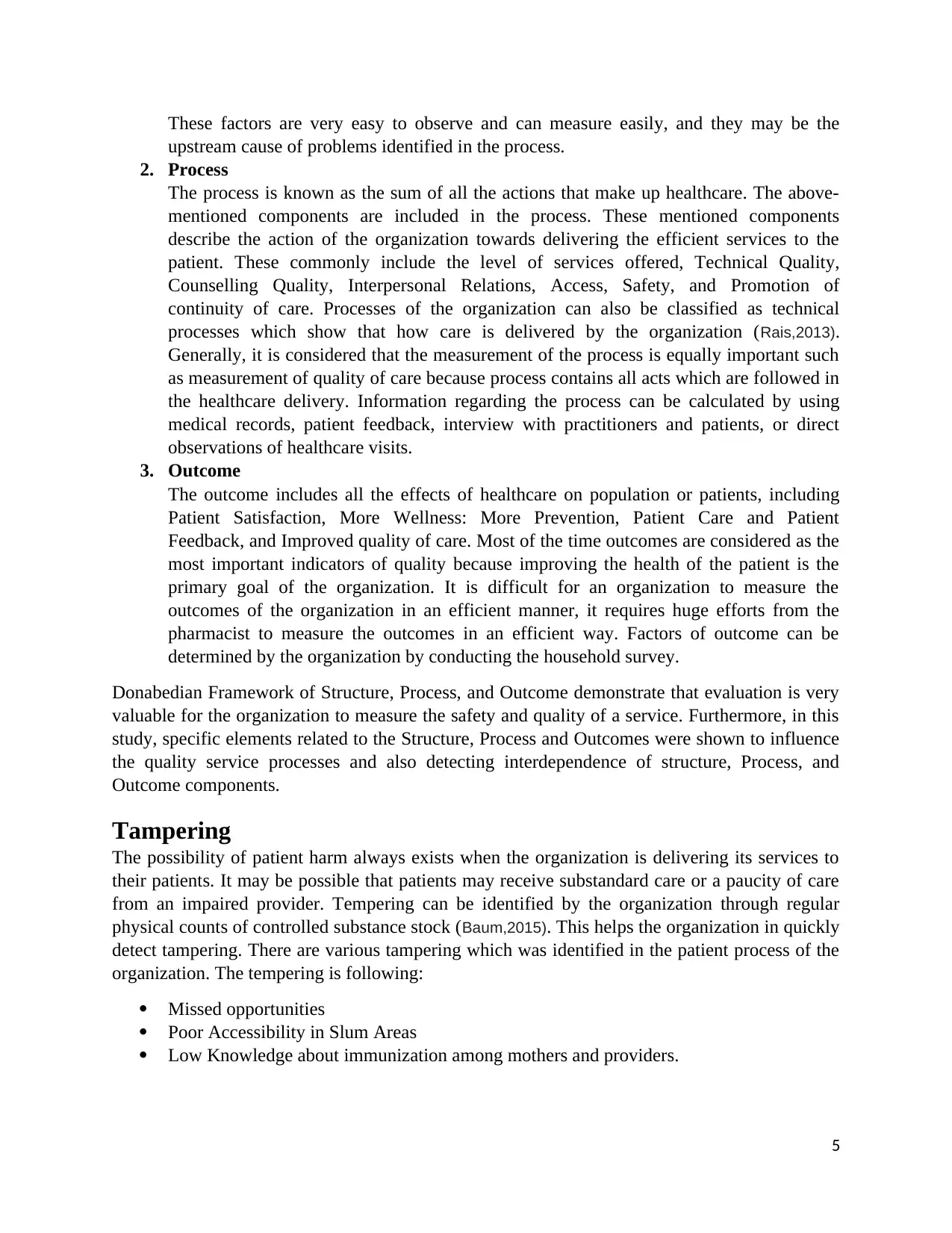
These factors are very easy to observe and can measure easily, and they may be the
upstream cause of problems identified in the process.
2. Process
The process is known as the sum of all the actions that make up healthcare. The above-
mentioned components are included in the process. These mentioned components
describe the action of the organization towards delivering the efficient services to the
patient. These commonly include the level of services offered, Technical Quality,
Counselling Quality, Interpersonal Relations, Access, Safety, and Promotion of
continuity of care. Processes of the organization can also be classified as technical
processes which show that how care is delivered by the organization (Rais,2013).
Generally, it is considered that the measurement of the process is equally important such
as measurement of quality of care because process contains all acts which are followed in
the healthcare delivery. Information regarding the process can be calculated by using
medical records, patient feedback, interview with practitioners and patients, or direct
observations of healthcare visits.
3. Outcome
The outcome includes all the effects of healthcare on population or patients, including
Patient Satisfaction, More Wellness: More Prevention, Patient Care and Patient
Feedback, and Improved quality of care. Most of the time outcomes are considered as the
most important indicators of quality because improving the health of the patient is the
primary goal of the organization. It is difficult for an organization to measure the
outcomes of the organization in an efficient manner, it requires huge efforts from the
pharmacist to measure the outcomes in an efficient way. Factors of outcome can be
determined by the organization by conducting the household survey.
Donabedian Framework of Structure, Process, and Outcome demonstrate that evaluation is very
valuable for the organization to measure the safety and quality of a service. Furthermore, in this
study, specific elements related to the Structure, Process and Outcomes were shown to influence
the quality service processes and also detecting interdependence of structure, Process, and
Outcome components.
Tampering
The possibility of patient harm always exists when the organization is delivering its services to
their patients. It may be possible that patients may receive substandard care or a paucity of care
from an impaired provider. Tempering can be identified by the organization through regular
physical counts of controlled substance stock (Baum,2015). This helps the organization in quickly
detect tampering. There are various tampering which was identified in the patient process of the
organization. The tempering is following:
Missed opportunities
Poor Accessibility in Slum Areas
Low Knowledge about immunization among mothers and providers.
5
upstream cause of problems identified in the process.
2. Process
The process is known as the sum of all the actions that make up healthcare. The above-
mentioned components are included in the process. These mentioned components
describe the action of the organization towards delivering the efficient services to the
patient. These commonly include the level of services offered, Technical Quality,
Counselling Quality, Interpersonal Relations, Access, Safety, and Promotion of
continuity of care. Processes of the organization can also be classified as technical
processes which show that how care is delivered by the organization (Rais,2013).
Generally, it is considered that the measurement of the process is equally important such
as measurement of quality of care because process contains all acts which are followed in
the healthcare delivery. Information regarding the process can be calculated by using
medical records, patient feedback, interview with practitioners and patients, or direct
observations of healthcare visits.
3. Outcome
The outcome includes all the effects of healthcare on population or patients, including
Patient Satisfaction, More Wellness: More Prevention, Patient Care and Patient
Feedback, and Improved quality of care. Most of the time outcomes are considered as the
most important indicators of quality because improving the health of the patient is the
primary goal of the organization. It is difficult for an organization to measure the
outcomes of the organization in an efficient manner, it requires huge efforts from the
pharmacist to measure the outcomes in an efficient way. Factors of outcome can be
determined by the organization by conducting the household survey.
Donabedian Framework of Structure, Process, and Outcome demonstrate that evaluation is very
valuable for the organization to measure the safety and quality of a service. Furthermore, in this
study, specific elements related to the Structure, Process and Outcomes were shown to influence
the quality service processes and also detecting interdependence of structure, Process, and
Outcome components.
Tampering
The possibility of patient harm always exists when the organization is delivering its services to
their patients. It may be possible that patients may receive substandard care or a paucity of care
from an impaired provider. Tempering can be identified by the organization through regular
physical counts of controlled substance stock (Baum,2015). This helps the organization in quickly
detect tampering. There are various tampering which was identified in the patient process of the
organization. The tempering is following:
Missed opportunities
Poor Accessibility in Slum Areas
Low Knowledge about immunization among mothers and providers.
5
⊘ This is a preview!⊘
Do you want full access?
Subscribe today to unlock all pages.

Trusted by 1+ million students worldwide
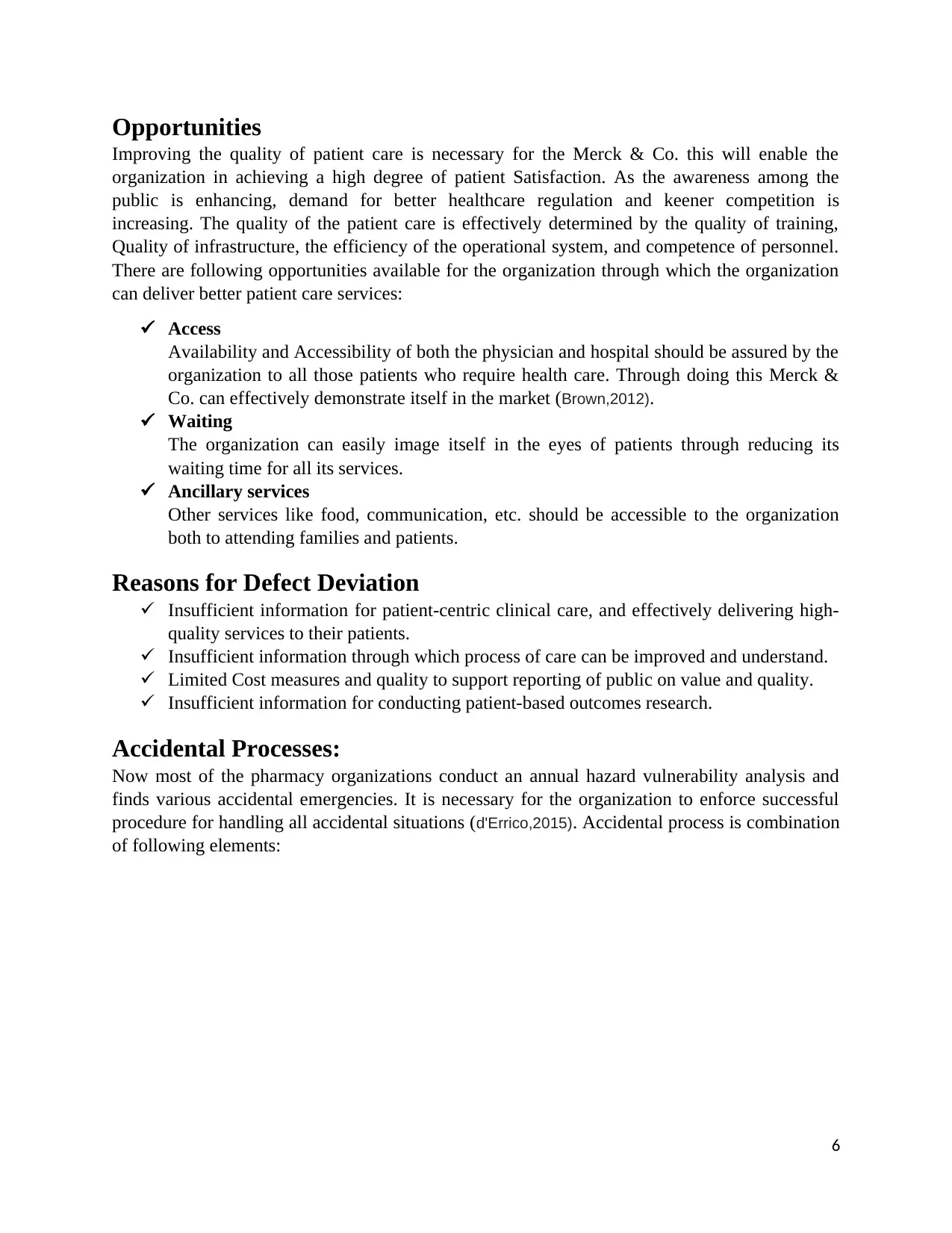
Opportunities
Improving the quality of patient care is necessary for the Merck & Co. this will enable the
organization in achieving a high degree of patient Satisfaction. As the awareness among the
public is enhancing, demand for better healthcare regulation and keener competition is
increasing. The quality of the patient care is effectively determined by the quality of training,
Quality of infrastructure, the efficiency of the operational system, and competence of personnel.
There are following opportunities available for the organization through which the organization
can deliver better patient care services:
Access
Availability and Accessibility of both the physician and hospital should be assured by the
organization to all those patients who require health care. Through doing this Merck &
Co. can effectively demonstrate itself in the market (Brown,2012).
Waiting
The organization can easily image itself in the eyes of patients through reducing its
waiting time for all its services.
Ancillary services
Other services like food, communication, etc. should be accessible to the organization
both to attending families and patients.
Reasons for Defect Deviation
Insufficient information for patient-centric clinical care, and effectively delivering high-
quality services to their patients.
Insufficient information through which process of care can be improved and understand.
Limited Cost measures and quality to support reporting of public on value and quality.
Insufficient information for conducting patient-based outcomes research.
Accidental Processes:
Now most of the pharmacy organizations conduct an annual hazard vulnerability analysis and
finds various accidental emergencies. It is necessary for the organization to enforce successful
procedure for handling all accidental situations (d'Errico,2015). Accidental process is combination
of following elements:
6
Improving the quality of patient care is necessary for the Merck & Co. this will enable the
organization in achieving a high degree of patient Satisfaction. As the awareness among the
public is enhancing, demand for better healthcare regulation and keener competition is
increasing. The quality of the patient care is effectively determined by the quality of training,
Quality of infrastructure, the efficiency of the operational system, and competence of personnel.
There are following opportunities available for the organization through which the organization
can deliver better patient care services:
Access
Availability and Accessibility of both the physician and hospital should be assured by the
organization to all those patients who require health care. Through doing this Merck &
Co. can effectively demonstrate itself in the market (Brown,2012).
Waiting
The organization can easily image itself in the eyes of patients through reducing its
waiting time for all its services.
Ancillary services
Other services like food, communication, etc. should be accessible to the organization
both to attending families and patients.
Reasons for Defect Deviation
Insufficient information for patient-centric clinical care, and effectively delivering high-
quality services to their patients.
Insufficient information through which process of care can be improved and understand.
Limited Cost measures and quality to support reporting of public on value and quality.
Insufficient information for conducting patient-based outcomes research.
Accidental Processes:
Now most of the pharmacy organizations conduct an annual hazard vulnerability analysis and
finds various accidental emergencies. It is necessary for the organization to enforce successful
procedure for handling all accidental situations (d'Errico,2015). Accidental process is combination
of following elements:
6
Paraphrase This Document
Need a fresh take? Get an instant paraphrase of this document with our AI Paraphraser
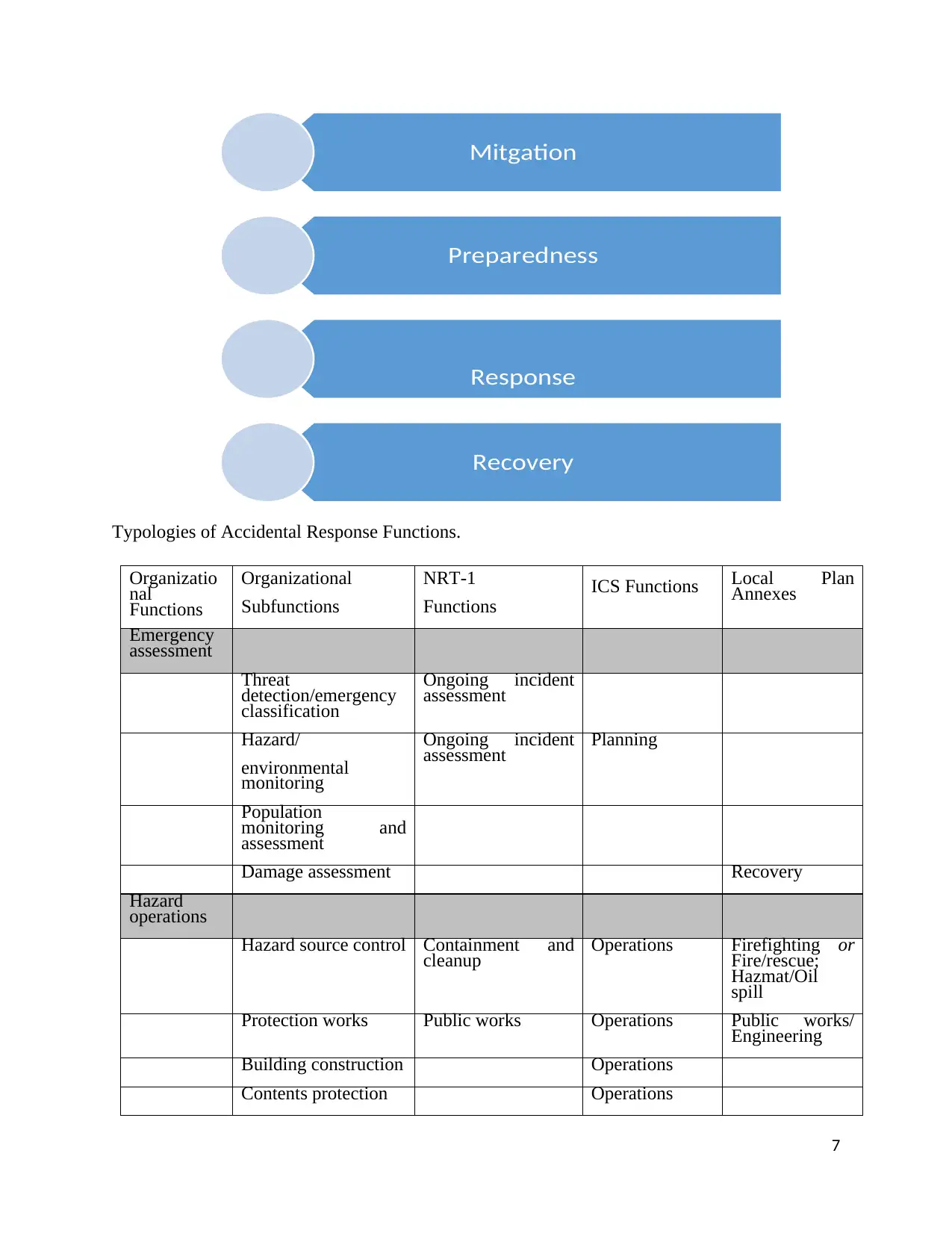
Typologies of Accidental Response Functions.
Organizatio
nal
Functions
Organizational
Subfunctions
NRT-1
Functions
ICS Functions Local Plan
Annexes
Emergency
assessment
Threat
detection/emergency
classification
Ongoing incident
assessment
Hazard/
environmental
monitoring
Ongoing incident
assessment Planning
Population
monitoring and
assessment
Damage assessment Recovery
Hazard
operations
Hazard source control Containment and
cleanup Operations Firefighting or
Fire/rescue;
Hazmat/Oil
spill
Protection works Public works Operations Public works/
Engineering
Building construction Operations
Contents protection Operations
7
Mitgation
Preparedness
Response
Recovery
Organizatio
nal
Functions
Organizational
Subfunctions
NRT-1
Functions
ICS Functions Local Plan
Annexes
Emergency
assessment
Threat
detection/emergency
classification
Ongoing incident
assessment
Hazard/
environmental
monitoring
Ongoing incident
assessment Planning
Population
monitoring and
assessment
Damage assessment Recovery
Hazard
operations
Hazard source control Containment and
cleanup Operations Firefighting or
Fire/rescue;
Hazmat/Oil
spill
Protection works Public works Operations Public works/
Engineering
Building construction Operations
Contents protection Operations
7
Mitgation
Preparedness
Response
Recovery
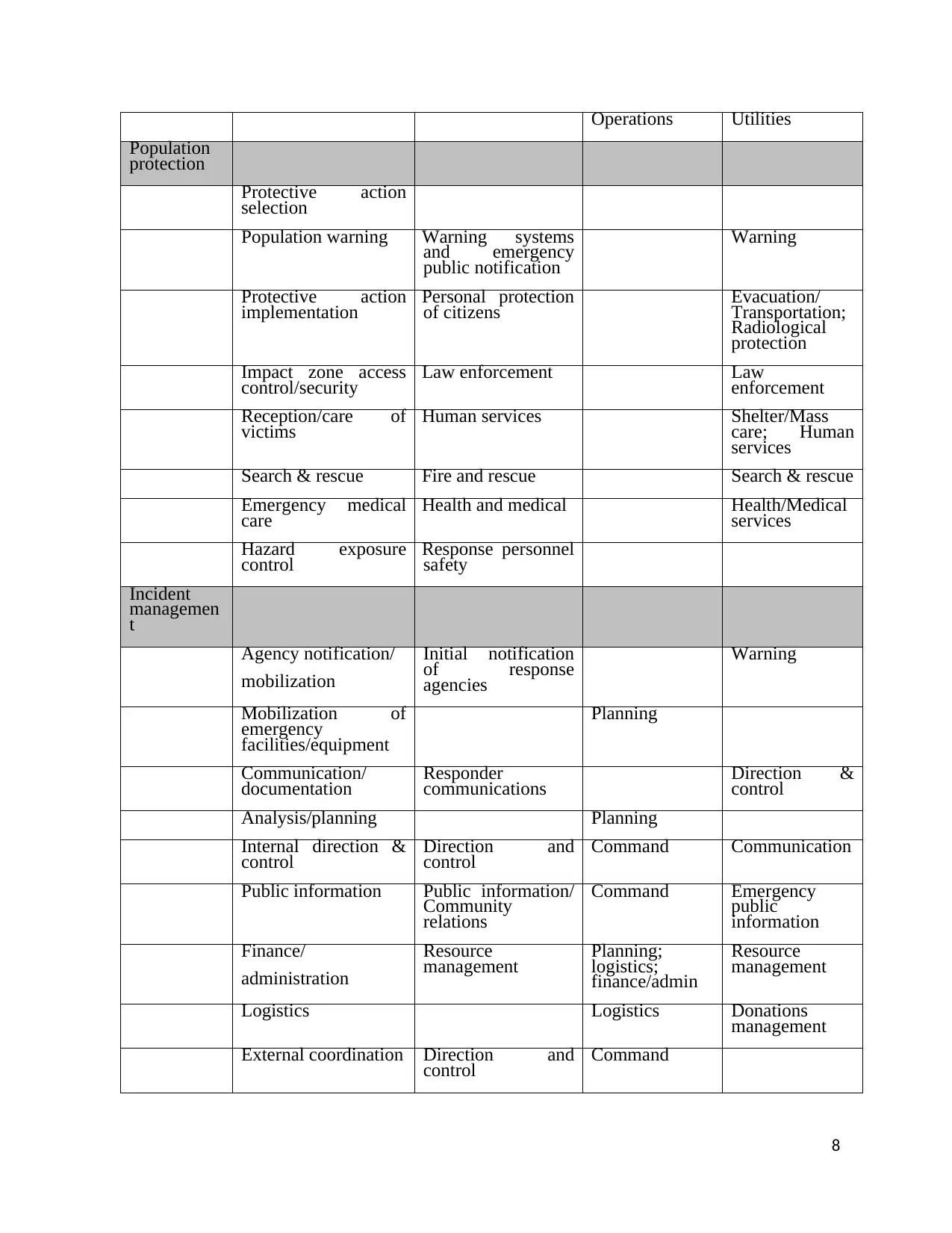
Operations Utilities
Population
protection
Protective action
selection
Population warning Warning systems
and emergency
public notification
Warning
Protective action
implementation Personal protection
of citizens Evacuation/
Transportation;
Radiological
protection
Impact zone access
control/security Law enforcement Law
enforcement
Reception/care of
victims Human services Shelter/Mass
care; Human
services
Search & rescue Fire and rescue Search & rescue
Emergency medical
care Health and medical Health/Medical
services
Hazard exposure
control Response personnel
safety
Incident
managemen
t
Agency notification/
mobilization
Initial notification
of response
agencies
Warning
Mobilization of
emergency
facilities/equipment
Planning
Communication/
documentation Responder
communications Direction &
control
Analysis/planning Planning
Internal direction &
control Direction and
control Command Communication
Public information Public information/
Community
relations
Command Emergency
public
information
Finance/
administration
Resource
management Planning;
logistics;
finance/admin
Resource
management
Logistics Logistics Donations
management
External coordination Direction and
control Command
8
Population
protection
Protective action
selection
Population warning Warning systems
and emergency
public notification
Warning
Protective action
implementation Personal protection
of citizens Evacuation/
Transportation;
Radiological
protection
Impact zone access
control/security Law enforcement Law
enforcement
Reception/care of
victims Human services Shelter/Mass
care; Human
services
Search & rescue Fire and rescue Search & rescue
Emergency medical
care Health and medical Health/Medical
services
Hazard exposure
control Response personnel
safety
Incident
managemen
t
Agency notification/
mobilization
Initial notification
of response
agencies
Warning
Mobilization of
emergency
facilities/equipment
Planning
Communication/
documentation Responder
communications Direction &
control
Analysis/planning Planning
Internal direction &
control Direction and
control Command Communication
Public information Public information/
Community
relations
Command Emergency
public
information
Finance/
administration
Resource
management Planning;
logistics;
finance/admin
Resource
management
Logistics Logistics Donations
management
External coordination Direction and
control Command
8
⊘ This is a preview!⊘
Do you want full access?
Subscribe today to unlock all pages.

Trusted by 1+ million students worldwide
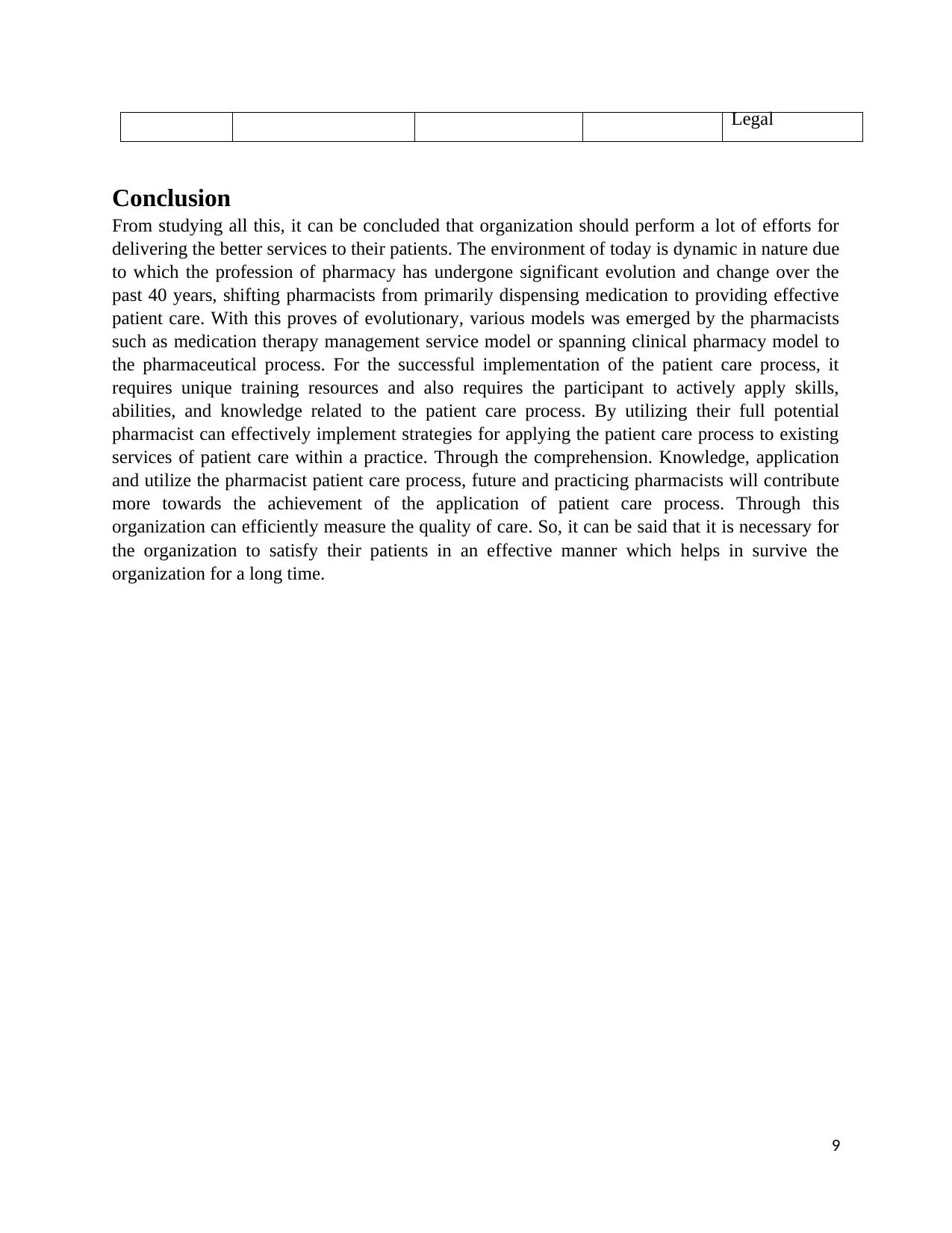
Legal
Conclusion
From studying all this, it can be concluded that organization should perform a lot of efforts for
delivering the better services to their patients. The environment of today is dynamic in nature due
to which the profession of pharmacy has undergone significant evolution and change over the
past 40 years, shifting pharmacists from primarily dispensing medication to providing effective
patient care. With this proves of evolutionary, various models was emerged by the pharmacists
such as medication therapy management service model or spanning clinical pharmacy model to
the pharmaceutical process. For the successful implementation of the patient care process, it
requires unique training resources and also requires the participant to actively apply skills,
abilities, and knowledge related to the patient care process. By utilizing their full potential
pharmacist can effectively implement strategies for applying the patient care process to existing
services of patient care within a practice. Through the comprehension. Knowledge, application
and utilize the pharmacist patient care process, future and practicing pharmacists will contribute
more towards the achievement of the application of patient care process. Through this
organization can efficiently measure the quality of care. So, it can be said that it is necessary for
the organization to satisfy their patients in an effective manner which helps in survive the
organization for a long time.
9
Conclusion
From studying all this, it can be concluded that organization should perform a lot of efforts for
delivering the better services to their patients. The environment of today is dynamic in nature due
to which the profession of pharmacy has undergone significant evolution and change over the
past 40 years, shifting pharmacists from primarily dispensing medication to providing effective
patient care. With this proves of evolutionary, various models was emerged by the pharmacists
such as medication therapy management service model or spanning clinical pharmacy model to
the pharmaceutical process. For the successful implementation of the patient care process, it
requires unique training resources and also requires the participant to actively apply skills,
abilities, and knowledge related to the patient care process. By utilizing their full potential
pharmacist can effectively implement strategies for applying the patient care process to existing
services of patient care within a practice. Through the comprehension. Knowledge, application
and utilize the pharmacist patient care process, future and practicing pharmacists will contribute
more towards the achievement of the application of patient care process. Through this
organization can efficiently measure the quality of care. So, it can be said that it is necessary for
the organization to satisfy their patients in an effective manner which helps in survive the
organization for a long time.
9
Paraphrase This Document
Need a fresh take? Get an instant paraphrase of this document with our AI Paraphraser
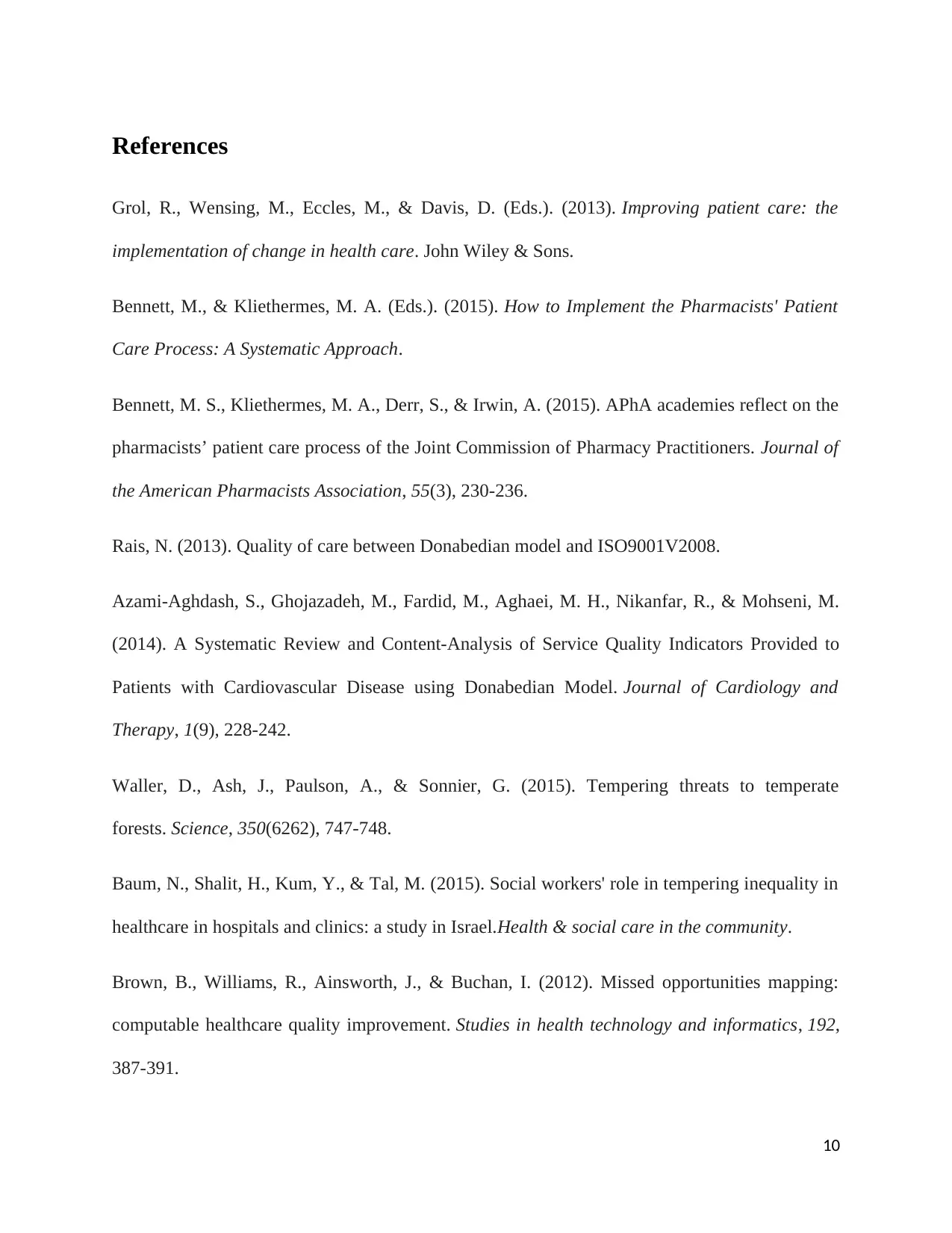
References
Grol, R., Wensing, M., Eccles, M., & Davis, D. (Eds.). (2013). Improving patient care: the
implementation of change in health care. John Wiley & Sons.
Bennett, M., & Kliethermes, M. A. (Eds.). (2015). How to Implement the Pharmacists' Patient
Care Process: A Systematic Approach.
Bennett, M. S., Kliethermes, M. A., Derr, S., & Irwin, A. (2015). APhA academies reflect on the
pharmacists’ patient care process of the Joint Commission of Pharmacy Practitioners. Journal of
the American Pharmacists Association, 55(3), 230-236.
Rais, N. (2013). Quality of care between Donabedian model and ISO9001V2008.
Azami-Aghdash, S., Ghojazadeh, M., Fardid, M., Aghaei, M. H., Nikanfar, R., & Mohseni, M.
(2014). A Systematic Review and Content-Analysis of Service Quality Indicators Provided to
Patients with Cardiovascular Disease using Donabedian Model. Journal of Cardiology and
Therapy, 1(9), 228-242.
Waller, D., Ash, J., Paulson, A., & Sonnier, G. (2015). Tempering threats to temperate
forests. Science, 350(6262), 747-748.
Baum, N., Shalit, H., Kum, Y., & Tal, M. (2015). Social workers' role in tempering inequality in
healthcare in hospitals and clinics: a study in Israel.Health & social care in the community.
Brown, B., Williams, R., Ainsworth, J., & Buchan, I. (2012). Missed opportunities mapping:
computable healthcare quality improvement. Studies in health technology and informatics, 192,
387-391.
10
Grol, R., Wensing, M., Eccles, M., & Davis, D. (Eds.). (2013). Improving patient care: the
implementation of change in health care. John Wiley & Sons.
Bennett, M., & Kliethermes, M. A. (Eds.). (2015). How to Implement the Pharmacists' Patient
Care Process: A Systematic Approach.
Bennett, M. S., Kliethermes, M. A., Derr, S., & Irwin, A. (2015). APhA academies reflect on the
pharmacists’ patient care process of the Joint Commission of Pharmacy Practitioners. Journal of
the American Pharmacists Association, 55(3), 230-236.
Rais, N. (2013). Quality of care between Donabedian model and ISO9001V2008.
Azami-Aghdash, S., Ghojazadeh, M., Fardid, M., Aghaei, M. H., Nikanfar, R., & Mohseni, M.
(2014). A Systematic Review and Content-Analysis of Service Quality Indicators Provided to
Patients with Cardiovascular Disease using Donabedian Model. Journal of Cardiology and
Therapy, 1(9), 228-242.
Waller, D., Ash, J., Paulson, A., & Sonnier, G. (2015). Tempering threats to temperate
forests. Science, 350(6262), 747-748.
Baum, N., Shalit, H., Kum, Y., & Tal, M. (2015). Social workers' role in tempering inequality in
healthcare in hospitals and clinics: a study in Israel.Health & social care in the community.
Brown, B., Williams, R., Ainsworth, J., & Buchan, I. (2012). Missed opportunities mapping:
computable healthcare quality improvement. Studies in health technology and informatics, 192,
387-391.
10
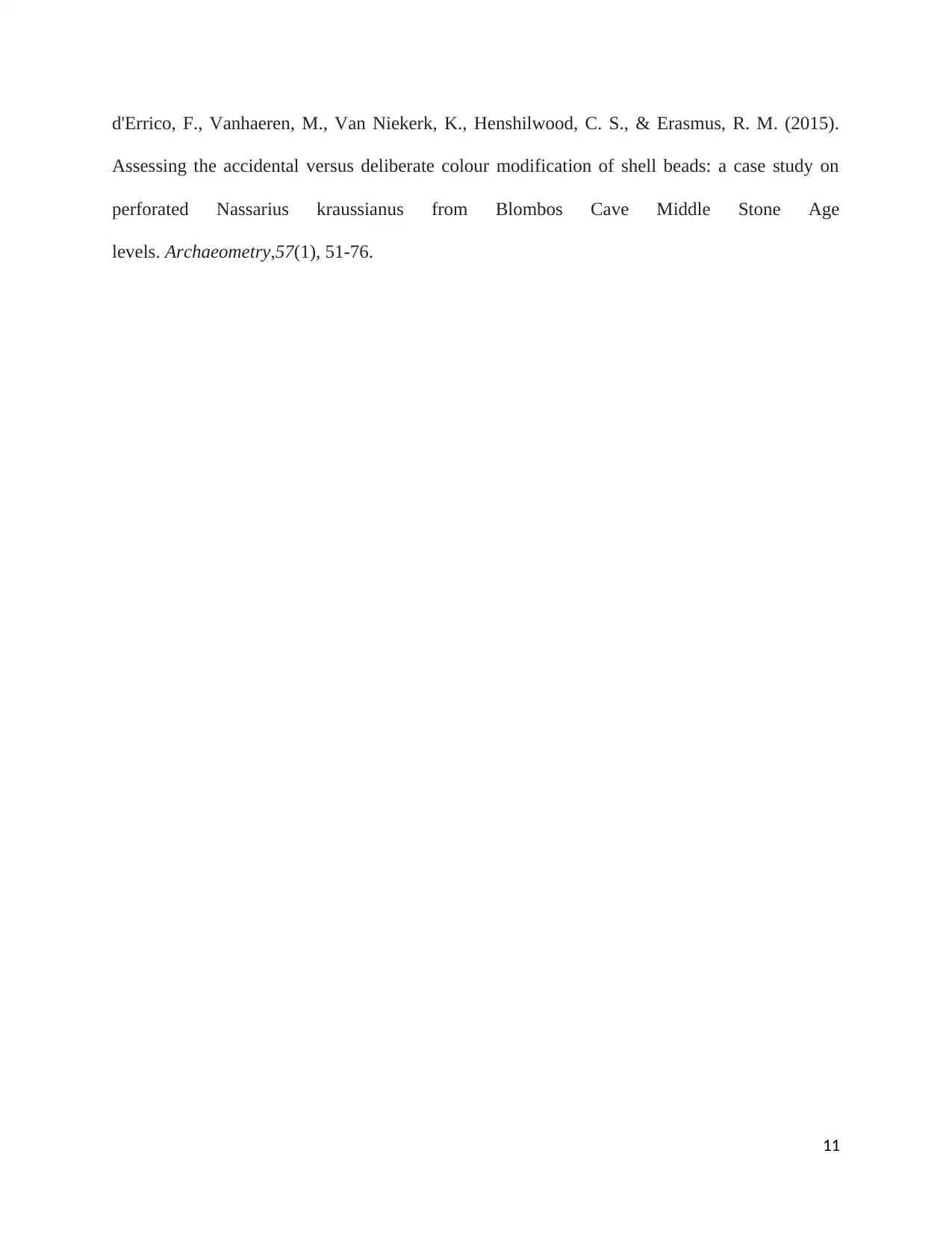
d'Errico, F., Vanhaeren, M., Van Niekerk, K., Henshilwood, C. S., & Erasmus, R. M. (2015).
Assessing the accidental versus deliberate colour modification of shell beads: a case study on
perforated Nassarius kraussianus from Blombos Cave Middle Stone Age
levels. Archaeometry,57(1), 51-76.
11
Assessing the accidental versus deliberate colour modification of shell beads: a case study on
perforated Nassarius kraussianus from Blombos Cave Middle Stone Age
levels. Archaeometry,57(1), 51-76.
11
⊘ This is a preview!⊘
Do you want full access?
Subscribe today to unlock all pages.

Trusted by 1+ million students worldwide
1 out of 12
Related Documents
Your All-in-One AI-Powered Toolkit for Academic Success.
+13062052269
info@desklib.com
Available 24*7 on WhatsApp / Email
![[object Object]](/_next/static/media/star-bottom.7253800d.svg)
Unlock your academic potential
Copyright © 2020–2025 A2Z Services. All Rights Reserved. Developed and managed by ZUCOL.




